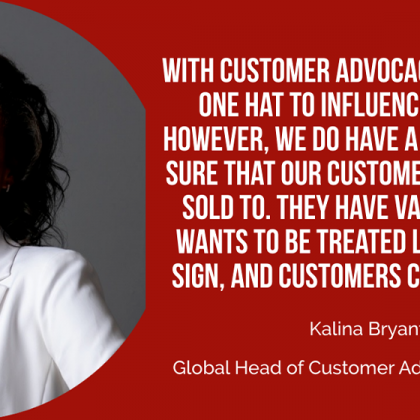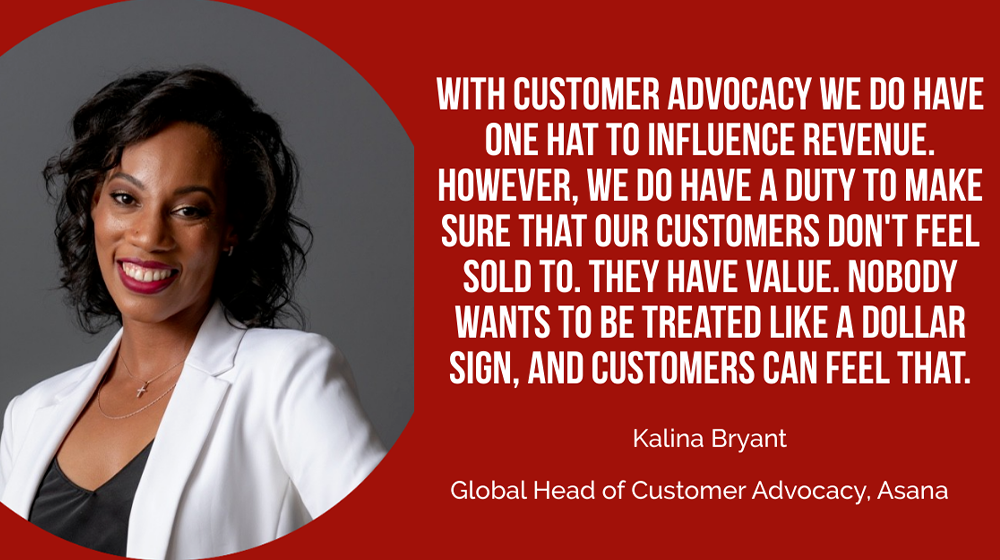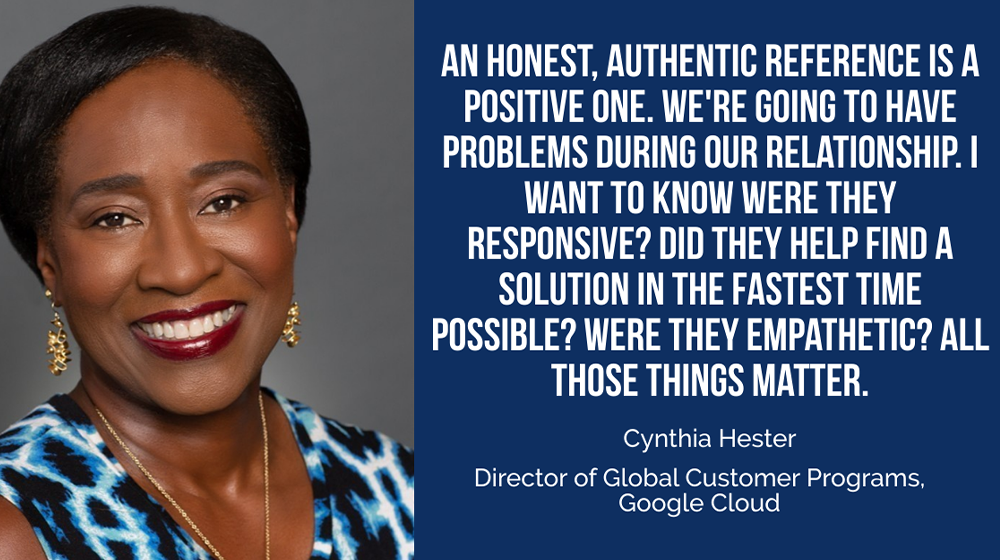Feature your business, services, products, events & news. Submit Website.
Breaking Top Featured Content:
Cynthia Hester of Google Cloud and Kalina Bryant of Asana: Customer Advocacy is more important to Customer Experience than Ever Before


What is customer advocacy? What role does it plays in the organization? How is it different from marketing? And what’s the importance of advocacy as part of a holistic customer experience?
It’s not often I have an opportunity to speak with two industries leaders together on an important topic like customer advocacy, but those were a few of the questions I asked Kalina Bryant, Global Head of Customer Advocacy for Asana, and Cynthia Hester, Director of Global Customer Programs for Google Cloud, recently during a great LinkedIn Live conversation.
Below is an edited transcript of a portion of our conversation. To hear the full conversation click on the embedded SoundCloud player.
Defining Customer Advocacy
Kalina Bryant: I am a true believer of if your customers are happy, you’re going to have a thriving business. And so on my end, I spent a lot of times figuring out how to build programs that are going to be beneficial to the customers, where we’re going to be able to gain feedback on our product. We’re going to be able to understand where we’re going, not just from a product standpoint, but from the needs of our customers. And so we spend a lot of time building things like our round tables from a virtual segment and my past building customer advisory boards, executive briefing centers, you name it. And that’s actually how I got in touch with Cynthia, a superstar in regards to building references programs. But that’s pretty much the layout, putting our customers first.
Cynthia Hester: And I’ve worked at some of the largest tech companies in the valley. I’m now at Google Cloud running our global customer programs, which includes all of our reference work, customer advocacy in general, and really making sure our customers have a great experience. And like Kalina, putting customer first is just one of my key tenants. Listening to their voice is another important key tenant. If we do those two things and we make the right decisions by the customer, then your business is going to thrive. You don’t have to worry about how you show up as a strategic partner if you do those basic fundamentals on a consistent basis.
My team is based around the globe. We support our global business kind of at a regional level. So we’re always looking for kind of strategic customers and customer engagement on a lot of different layers and through a lot of different personas. Right?
So everything from the C-suite all the way down to developers and practitioners. And I treat all the kids equally, they’re all really, really important and their voices are important. They have different perspectives, different points of view, and I know we’re going to talk a little bit about that in a minute. But that is really kind of why I love this work. I love seeing what customers are doing with the technology. So whether it’s Google, or when I was at Salesforce, or VMware, what are they doing with that technology? How are they using it to change the lives of their customers, their communities, their employees?
The Changing Role of Customer Advocacy due to the Pandemic

Brent Leary: But your role in your eyes, how has that changed since the pandemic hit? And then maybe take a step, a little higher view of it. How has the role of customer advocacy changed within the organization due to what’s been going on?
Cynthia Hester: Both really good questions. I think the role during the pandemic just became even more critical. So from my perspective and point of view, it’s always been essential to having a really good thriving business and doing right by your customers. But certainly during the pandemic, we had to double down very, very quickly in terms of polling and understanding what our customers experience was, what they were doing. And not just from their work with us, but really what was going on in each one of their environments, each one of their companies, their own industries.
We had some customers that were absolutely set up and could switch really quickly to get their employees working safely at home. We had other customers that struggled to do that. And whether it’s a Google Cloud customer or customers from my days back at VMware or Salesforce, same situation. Right? All of a sudden, all of us had to go from really doing a lot of face-to-face work and engagement to doing it all remotely. One of the things we did right off the bat last March, was just checking in with all of our strategic partners, the customers we work with the most, “How are you doing? How are your employees doing? Is this the right time? Did you need to take a pause?” And adjusting our strategy and our priorities based on the feedback we got from them. And we’re going to continue to do that, to meet at the same level.
And again the second part of the question was like, “Hey, how do we continue this? And how has it changed us?” I think, for the long-term. And that is, you need to be focused on it. If you’re not investing in those programs, if you’re not investing in those teams, do it. Do it now and do it quickly, because they’re going to be the lifeblood of how your business continues to grow and thrive.
This will not be the last pandemic. I wish it was going to be. I think history has shown us, something else could happen in our world that changes our business environment, in terms of how we engage with each other. And so I think by always having your finger on the pulse of what’s going on with your customers and being able to reach them and connect with them quickly and easily, gives you the ability to be much more agile and much more responsive when things do happen, like we saw last year.
Kalina Bryant: You hit the ball there, Cynthia. I think with customer advocacy, we struggle, right? Does it sit in marketing? Does it sit in customer success? And I think when you take a step back and people ask, “Well, how do we keep engaging with our customers,” That was a big question for me, “Regardless of what environment you were in and how do you constantly still get feedback from your customers, regardless if it’s in-person or virtual?” And when those questions started populating from more senior leaders within companies, I think that’s when the need became very crucial.
And so when you think about it, you have individuals that are giving you that product feedback, whether that’s a council or customer advisory board. But then you also, from a sales perspective, you can’t really close large deals without the voice of the customer. You need to have a solid reference where you have two to three customers that are willing to go to bat for your product.
And I think that originally, people started thinking about customer marketing as you know, newsletters and speaking engagements here and there. But when they really started associating, “Hey, we want to close larger enterprise deals. And every time we get to the very end of the road, they request some of the like-minded customers that can speak highly of the product.” And I think that that’s when the dynamics started changing because many companies they see the need, it needs to be scalable. It needs to be trackable.
And I think when individuals started looking at customer advocacy as an influence of revenue, especially during the pandemic, I think that that’s one customer marketing has gotten a more positive light or just more attention, I would say. Because without the influence of revenue, how are we going to scale regardless of what environment you’re in? And I think that that was the big wakeup call during the pandemic. The business still needs to keep going and you still needed to have people to validate. And this point, we’re taking away the conferences – you still have virtual conferences, but you’re taking away that in-person engagement with customers and partners. But if you have a trusted list of customers that value your time and your opinions, and the relationship that customer advocacy builds with those customers, you can still run a successful business. And I think that that’s the positive side of customer advocacy that people have the opportunity to see during the pandemic.
Both Sides of Customer Advocacy in Tough Times
Brent Leary: As a customer advocate, you’re really looking to build strong relationships with customers and give them a sense of comfort, that you guys are looking after them. But during a pandemic, when businesses are really getting hit hard, there could be added pressure on folks like you from internal folks saying, “Hey, can you help us do something? We were trying to really get something over here done and need help with a customer.” Did you feel any additional pressure, as to making sure that your role as an advocate really looks out for the customer?
Kalina Bryant: I think the value of customer advocacy was we were able to hear live feedback from our customers. We’ve done tons of reports at Asana, where we experience a lot of burnout, you have all this feedback of people just drained all the time, especially with our anatomy of work. We had a full on layout that really went into detail on that index. And when you think about it, based on some of that feedback, I was able to bring some of our key customers together for virtual round tables, both in January, and actually just recently in April. And the thing that we’re figuring out is, customers just want to be heard.
And so with customer advocacy, yeah, we do have one hat to influence revenue. However, we do have a duty to make sure that our customers don’t feel sold to and they actually still have value, they still have a certain perspective, and they’re treated a certain way. Nobody wants to be treated like a dollar sign, and customers can feel that. But when you’re creating this environment, and I think that’s the beauty of customer advocacy, we create a safe space for their voices to be heard, number one, and number two for their feedback to actually be taken and leveraged. And I think that that’s when you see a positive dynamic with customer advocacy and you see positive influence with revenue, because then you start to see these expansions. Then you start to see these additional introductions where they are invested in your product, not just in one segment of the business, but now in multiple segments because they trust you.
Cynthia Hester: And I think you raise a really good question, because I feel like last spring there was this period of time, maybe it was like the first two or three months when we went into lockdown across the country, really across the globe, and I feel that a lot of businesses took a pause and were very, very aware that we were all in this together, whether you were a vendor or a customer. And when you think about it, every business is on both sides. Right? You’re somebody’s customer, as a small business, and you have a customer. The same with Salesforce, Google, Asana, all of them, they’re somebody’s customer and they have a group of customers. And I think there was a period where we were all in it together. Internally, people got that. And so the pressure from marketing or sales, actually kind of everybody took a step back.
We were all focused on staying healthy, staying safe, keeping our family safe. And it created a very unique, to me, moment in time. Because for once, everybody really had aligned to the same goal almost by force, but truly aligned to the same goal around personal safety, wellbeing, and health of our families and our communities.
Cynthia Hester: And I think probably around May, June, some areas in some segments of the industries that we support and serve, some areas of our business, especially, everybody was like, “Okay, I think we got this. We’re good with remote work. We’re figuring out how we need to engage. Now we want to get back to it.” But everybody wasn’t in the same position. And so there were definitely times when I felt the need just to speak up and say, “You know what? This group of customers, they’re still struggling a little bit. They’re still having challenges. They still want to be on hold,” and really representing them well and advocating for them within the organization.
The positive side was, everybody got it. So the minute you said, “Hey, they’re not ready yet.” “Okay. What else are we going to do?” And people were very willing to switch gears, get creative around, what are the things that we can do. And I think you’re going to see more of that increasingly as everybody starts to come out of it and we go into this economic recovery, is folks are going to say, “Okay, we actually don’t want to go back to the way we were doing it before the pandemic. We now have a new way to work and we like it. It’s more flexible. I can be more creative with my teams, which then gives me the ability to influence the revenue that Kalina’s talking about of all of these programs and how do we engage them.”
Because the tenants still hold true. You still want to listen. You still want to put them first, and you want to make sure you’re making the right decisions by them. But how we do it, that how piece, I think, is still going to be in flux for a while. And folks should get comfortable with some of that uncertainty and know that the things we did all through the pandemic that got us through, will serve us well after the pandemic. And I just think there are things that are changing, that are changing for the good.
Role of Customer Advocacy in a Post-pandemic World
Brent Leary: And what role do you see customer advocacy playing in the post pandemic world? Is it different? Is it expanded?
Kalina Bryant: I do think that it depends on the size of the business. And I always look at what are the top business goals for that company, because that’s always determined how your customer advocacy programs are rolled out. But I do believe that customer advocacy drives really well in an enterprise segment, when you’re looking at your strategic accounts and enterprise accounts. And then if that’s the case, then personally, I shape my programs to touch more of the senior individuals. So it could be that VP and above, but that’s specifically if we’re looking at enterprise and strat accounts.
But, if you’re going into customer advocacy from a startup perspective, your layout might be a lot different. You might be just starting out on a community of customers. How do you develop champions, is a big question. So you can work your way up. I use this pyramid that really highlights, okay, customer champions, I’m working with customer success. And then you go into a full on community. We have a full community department. What does it look like when that community department is thriving and how is that benefiting the business? And then from there I look at, “Well, how are we doing these in-person or virtual engagements?” Really bring in the VIP experience, whether that’s a round table or a customer dinner, you name it.
Cynthia Hester: I agree. I think the importance of customer advocacy, customer marketing is only going to continue to increase. With your competitive environment, being in a lot of industries, again, the innovation from a technology perspective, from workflows and processes, from a perspective of how are you engaging with your employees, customers are at the heart of all of that work. And so I see it as becoming increasingly important. And again, for companies that have not typically invested in and paid attention to those programs, I say, “You ignore it at your peril.” At some point, it will come back to bite you, so to speak. Because you can’t ignore the very people you’re trying to serve. And none of us has all the answers. So one of the reasons I love this work is, I always learn something from these engagements and from these conversations.
And whether you have a program that’s a marquee program, where you’re focused on the executive C-suite, or you’re working with communities of practitioners and developers, they all are very important parts of the ecosystem. The CIO may not know the intricacies and all the best practices developed with the product, but the person that was responsible for implementation, migration, and support of that product, they will know. So you need both voices.
You need that executive voice that says, “Hey, this is the business impact. I know that this product or service or solution is having to my business and aligns to my OKRs, my goals.” And then at some of the other levels of the organization, in terms of what work is being done, whether it’s developing the migration, whether it’s adoption within the organization, whether it’s just supporting stakeholders, they have a very different perspective and point of view. They know what it’s like to work with that vendor day to day, they know how easy it is to do business with that vendor. They know how well that vendor supports you. So you need both of those. In a large deal, we can see customers requiring five or six different types of references from different parts of the organization based on function. because the CIO wants to make a very informed decision and you need all the voices to be able to do that. So you can’t make it on your own and you need to understand, “Oh, these four references said they had a really great experience with this company, and here’s why.”
The other thing that people can get over-rotated on is wanting the reference to always be “completely positive”. And the reason I put that in quotes is an honest, authentic reference, is a positive reference. We’re all human, everybody makes mistakes, every organization makes mistakes. What I look for when I’m doing references for agencies or even software that I’m adopting is, “If there was a problem, how did they respond to it?” Because I’m expecting, we’re going to have a problem at some point in our relationship. And what I really want to know and hear about is, “Were they responsive? Did they help us get to a solution that was appropriate in the fastest time possible? Were they kind of considerate and empathetic to our situation?” All of those things matter.
The problem, yes, we would love to have an implementation that has none. I’ve been working a long time, never had anything go smoothly from beginning to end, and I’m sure everybody in the audience has the same experience. But what’s really, really important is, “Who were those partners in those companies that you’ve worked with that have helped you get to a solution, stayed with you, and really engaged with you so you could actually do the work that you needed to do? And that, to me, is always where you want to be, is knowing that your customers are going to give you a very well-rounded reference. And to me again, if it’s authentic and it’s honest, then it is a good reference.
This article, “Cynthia Hester of Google Cloud and Kalina Bryant of Asana: Customer Advocacy is more important to Customer Experience than Ever Before” was first published on Small Business Trends


